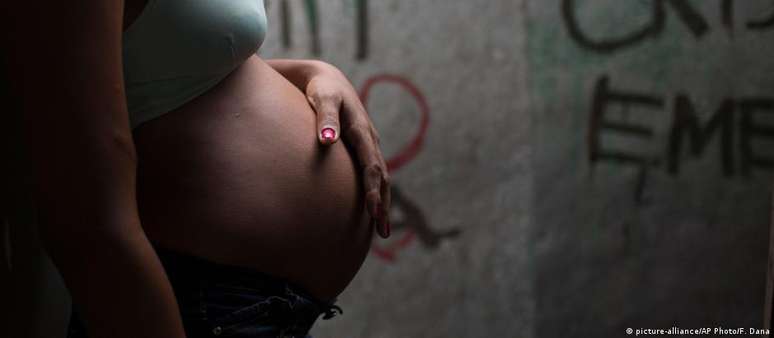They are a quarter of Brazilians between 15 and 29 years old and a portrait of inequality in Brazil: mostly poor, black and women.Carioca Carolina Cristina de Barros was 15 years old when her pregnancy test came back positive. Yan Lucas was born in July 2016, leading the young woman to interrupt her studies and face the dual challenges of being a precocious mother and a single mother. Her father, her boyfriend at the time, never helped her.
Born in 2000, Carolina faces one of the evils of the millennium: the limbo of “neither-nor” young people, who neither study nor work. The situation affects young people around the world, but she has alarming rates in Brazil, where she finds aggravations related to poverty, race and gender.
According to data from the Brazilian Institute of Geography and Statistics (IBGE), 10.9 million young Brazilians between the ages of 15 and 29 neither study nor work, or 22.3% – or one in five – of this age group .
The majority of these young people are poor (61.2%) and women (63.4%). Nearly half (43.3%) are black or brown women. Carolina is part of all three statistics. She lives alone with her son in Senador Camará, a favela in Bangu, in the western area of Rio de Janeiro.
“I go to the streets, I leave my CV, but it’s very difficult. Because I wasn’t able to finish my studies and also because I’m black. In other words, first job, incomplete studies, no experience… They reject my CV”, he summarizes the young woman, now 23 years old.
According to the Organization for Economic Co-operation and Development (OECD), Brazil has one of the worst rates of young people in this situation compared to 38 other countries. According to the Education at a Glance report, as of 2023, the country is ahead of only South Africa, Colombia, Chile, the Czech Republic and Turkey in this regard. While in the countries analyzed an average of 14.7% of young people between 18 and 24 years old do not attend school or work, in Brazil the percentage reaches 24.4%.
Estimated loss of R$46.3 billion to GDP
The number of young people neither studying nor working is an important indicator not only of youth vulnerability, but also for measuring the loss of productive potential in an economy – in the present and in the long term, since this is a workforce that can last decades.
If this part of the population was active in Brazil, the GDP in 2022 would have grown by R$46.3 billion. The National Confederation of Commerce in Goods, Services and Tourism (CNC) realizes this, according to a study published this month (15/01) based on IBGE data.
The OECD report, based on 2022 data, highlights the importance of governments developing public policies to prevent young people from entering this situation, or to get them out of it as quickly as possible. Difficulties in the transition from school to the labor market in early adulthood can have long-term consequences for a young person’s life, and the longer they spend in this situation, the more difficult it will be to leave it.
Wasted potential
For economist and IBGE analyst Denise Guichard, it is essential that government, businesses and society look more closely at young people in this vulnerable situation.
“We must take care of today’s young people. This is a huge loss of productive potential and human capital. There are 11 million young people outside the job market and the education system, so many wasted opportunities,” he underlines. “The people lose and the country loses.”
The term nem-nem is the Portuguese version of the English acronym NEET (not in education, employment, or training).
Many reject the expression because it suggests that the young person is responsible for the situation. Some economists prefer to talk about “without-without”, that is, without school and without work, to reinforce the inequalities and lack of opportunities at the root of the problem.
The reasons why young people do not go to school and work highlight multiple barriers, including low quality of education, lack of access to the labor market and inequality of opportunities and training.
Obstacle race
Geovani Cunha, 21, finished his studies three years ago, but has not yet found a job, despite the insistent routine of distributing CVs.
His struggles reflect the problems faced by poor, young people of color like him: from public education, which he considered weak (“teachers were more absent than present”) to the stigma he feels when leaving the favela where he lives for the wealthier . neighborhoods in the south of Rio (“we see the judgment in people’s eyes. In the south, all the blacks are favela dwellers, bums, thieves”).
“I’m running after it, but I promise you it’s not easy. Waking up early to send in your resume, knowing I’ll run out of lunch, feeling sick in the sun queuing for work. The boss doesn’t care about your problems, whether you ate or no.”
The boy dreams of joining the Armed Forces. He passed two tests to become a firefighter and marine, but could not continue the selection process due to lack of money to take the necessary medical exams.
Geovani was raised by his grandparents. He has little contact with his mother; His father spent part of Geovani’s childhood in prison and died after a motorcycle accident due to medical negligence. The young man grew up in a neighborhood in the coastal city of Mangaratiba, two hours from the capital, but moved to Rio because there were no jobs there.
Today he lives with his aunt in Vila Vintém, a community in the western area of Rio and, in search of work, he does odd jobs to survive: changing light bulbs, repairing electrical cables, selling sweets on the train that connects Realengo to the Central do Brasil station, in full Center, about 30km.
Geovani saw friends engaging in drug trafficking. He saw someone murdered. The path of money through crime is “on the doorstep, walking on the square”, he describes.
“Everything seems to be going in the wrong direction. Life takes us in the wrong direction. Thank God, I have always had my head in order,” he says, saying his faith in Umbanda gives him support.
Disproportionate burden on women
However, for a large number of young people without school and without work, the obstacles of the job market still seem far away. This is because 66% of them are not even looking for a job and it is in this group that gender roles appear most significantly.
The most common reason is the need to take care of relatives or household chores. And this reason disproportionately affects women, especially black women. Of the 7.1 million young people who are not looking for work, 2.5 million are women engaged in domestic work or caring for the family.
According to Denise Guichard, women find it harder to escape this statistic as they age. “Men launch themselves and enter the job market, but women stop,” underlines the IBGE analyst.
This year little Yan Lucas will turn 8 years old. Carolina, who is about to turn 24, lives on the R$600 a month that she receives from Bolsa Família and on the change that she earns working as a manicurist and hairdresser in the neighborhood. “We were in a difficult situation, but I ran after him to give him some things,” she says.
However, determined to get out of the situation caused by early motherhood, Carolina has just taken out a night supplement to complete high school. The course, in a municipal school, allows mothers without a support network to take their children to school.
Carolina hopes that by completing high school, she will have a better chance of entering the job market. She dreams of studying nursing.
“I can’t wait to start classes. To finish my studies and to finish this phase of my life soon. To start 2024 differently,” he says.
Source: Terra
Rose James is a Gossipify movie and series reviewer known for her in-depth analysis and unique perspective on the latest releases. With a background in film studies, she provides engaging and informative reviews, and keeps readers up to date with industry trends and emerging talents.



![A Better Life Preview: What’s in store for Friday, October 24, 2025 Episode 449 [SPOILERS] A Better Life Preview: What’s in store for Friday, October 24, 2025 Episode 449 [SPOILERS]](https://fr.web.img6.acsta.net/img/16/27/1627e795b389773da60b2ef0a5dfdfd0.jpg)



